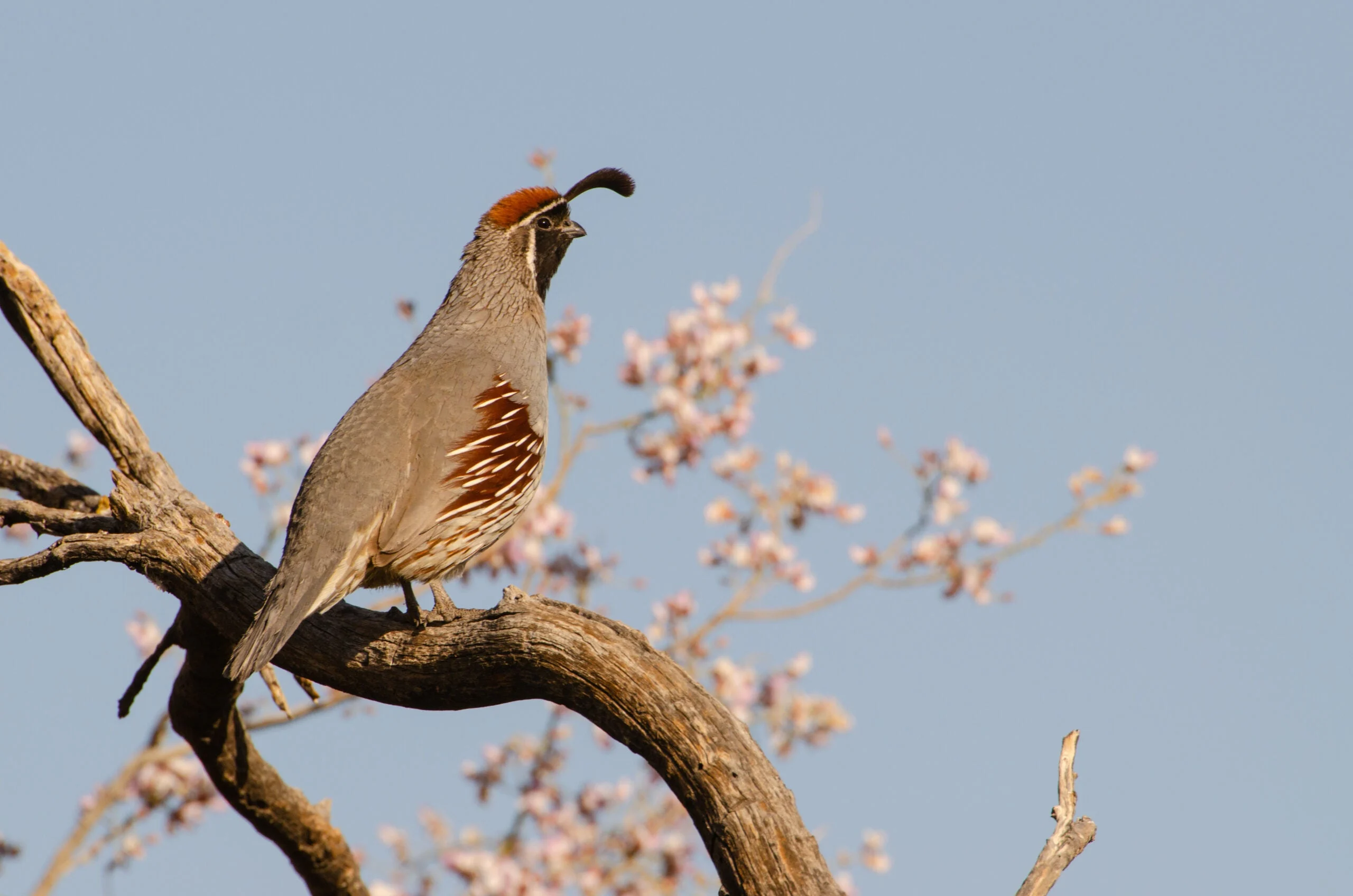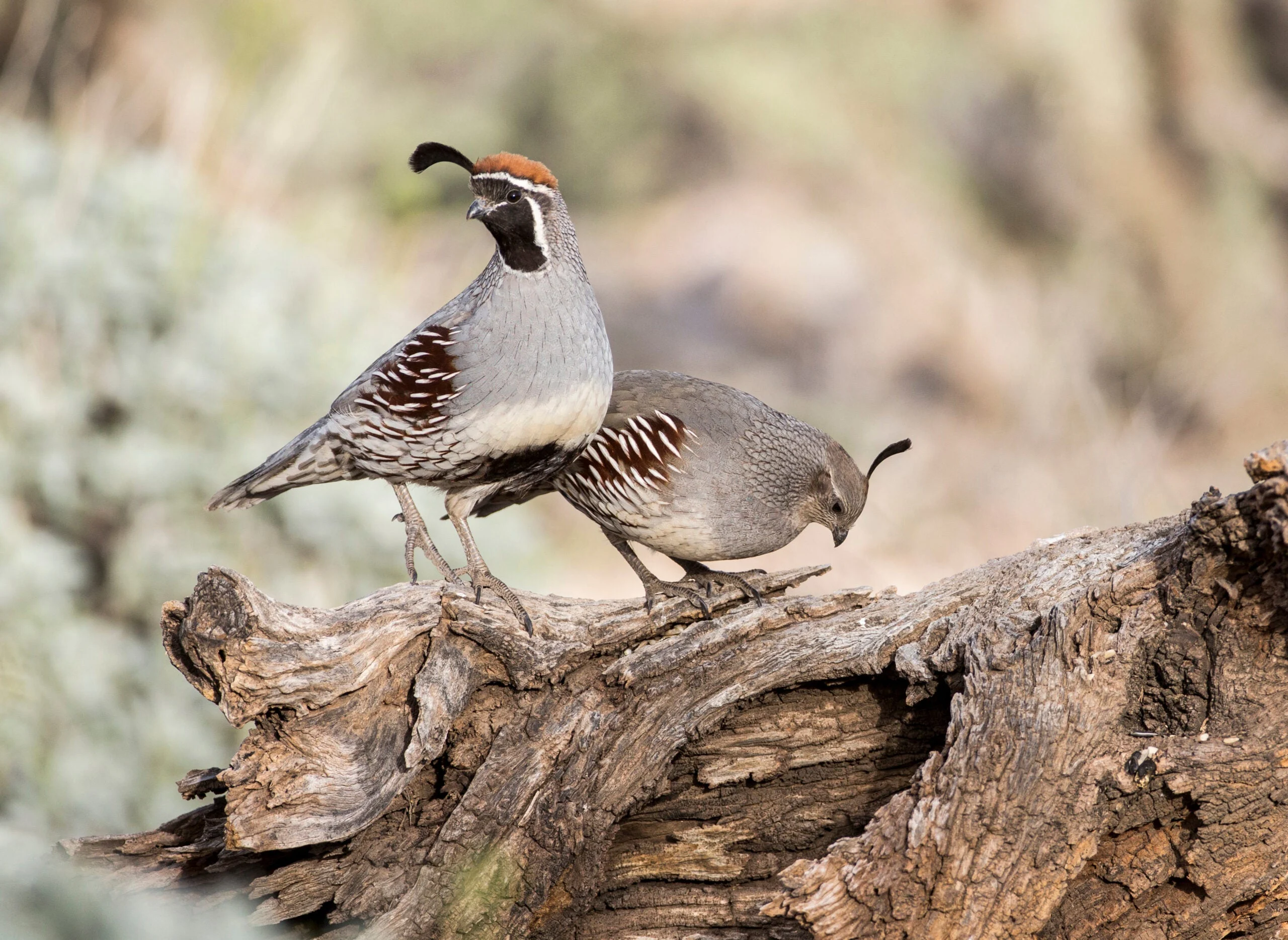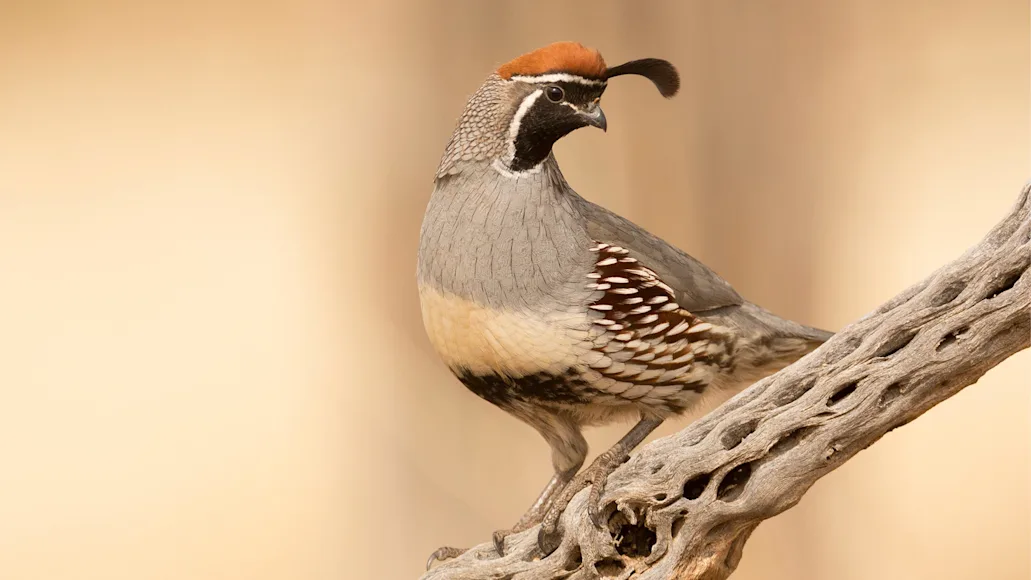A covey of gambel’s quail scurrying through the desert with their topknots bobbing is a common sight in parts of the southwest. Adapted to live in arid climates, the gambel’s is especially associated with Arizona. This small gamebird
sports an identical topknot to that of the California quail
and plumage so similar it can be hard to tell the two species apart at times. Besides similar appearances, the two birds live practically next door to one another and occasionally interbreed to produce hybrids.
The gambel’s quail, however, is a separate species living in the hot, dry desert. It finds everything it needs in the desert, including cactus fruits and flowers, which make up part of its diet. Gambel’s quail are plentiful throughout their range, especially in Arizona, where they are a delight to both wildlife watchers and upland hunters.

A male gambel’s quail perched on a branch. Tonia/Adobe Stock
Appearance, Range, and Habitat
Like the California quail, with which it can be easily confused, both male and female gambel’s quail sport topknots. The male has a black face with white marks and a chestnut crown. Blue-gray plumage covers its back and wings, with a russet and white patch on its sides and a buff belly. The lower belly of the gambel’s quail also has a distinctive black patch that distinguishes it from the similarly-marked California quail. The female is a striking bird on her own, with similar body plumage as the male, if slightly toned down, and a browning face. The gambel’s quail measures almost ten inches in length and weighs 5.5 to 7 ounces, making them slightly larger than a bobwhite
.
The gambel’s thrives in the desert, with a range that stretches from southeastern California and the southern tip of Nevada through almost the entire southern half of Arizona and into New Mexico, as well as in parts of southwest Colorado and southern Utah. A few gambel’s quail survived stockings on Kaho’olawe and the big island of Hawaii.
These birds need brushy cover and seem to have a special affinity for honey mesquite in Arizona. They live around and feed on the fruits and flowers of yuccas, prickly pear cacti, and the icon of the Arizona desert, the Saguaro cactus. While gambel’s can get much of the moisture they need from green plants, they exhibit a preference for washes and riparian habitats. They can also survive in more agricultural environments. Gambel’s quail typically roost off the ground in brush or trees, dropping down to feed early and late to stay out of the heat, searching for food in coveys of a dozen or so birds. In the mid-day heat, they will retire to heavier cover. Their home range is fairly small, from 40 to 200 or so acres.
Like other quail, gambel’s have short beaks suited for picking seeds, grasses, and forbs. They will pick mesquite seeds from cattle and coyote droppings. They also eat leaves and grass blades. From summer into fall, berries and cactus fruit, including cholla, saguaro, and prickly pear, become an important part of the diet. In spring and summer, they feed on insects. Insects also make up the entire diet of gambel’s quail chicks until they are big enough to forage for seeds.
Breeding Behavior
In the spring, the male gambel’s Quail finds an elevated perch and makes a sound often described as kaa or cow to attract a female. Once a female approaches, the male begins an elaborate ritual called “tidbitting” in which he simulates foraging while fanning his tail and keeping his head low. Sometimes, the male offers bits of food, hence the name “tidbitting.” Once bonded, gambel’s quail usually remain monogamous, although in some cases, the hen will leave the male to raise the brood, find a new mate, and nest a second time.
Hens scoop out a nest on the ground and lay between five and 15 eggs. Once hatched, the chicks feed on insects, and the family group stays together, forming a covey that will remain together into the fall. Some coveys, however, can number up to 70 birds.

A male and female gambel’s quail stand side-by-side on a log. Jaynes Gallery/Danita Delimont/Adobe Stock
Gambel’s Quail Conservation Concerns
Gambel’s quail populations remain quite stable across their desert range, although the term “stable” doesn’t convey the ups and downs of gambel’s populations. The birds flourish in wet years and decline in times of drought. In some cases, grazing of gambel’s range reduces the amount of food and cover available but populations remain healthy. In the 1950s, severely restricted hunting seasons, low bag limits, and even closed seasons failed to increase populations in the 1950s. Now, hunting seasons run for months, with generous bag limits, and quail populations remain in good shape.
Hunting Gambel’s Quail
Gambel’s quail hunting, like any upland hunting
, begins with identifying good cover. Areas with grass that’s six or more inches high, brush, mesquite, and food such as seeds or cactus fruit are key. Typically, coveys prefer to run and/or flush wild. Often the best way to proceed is to flush the covey, then hunt up the singles, which will often sit very well for a dog. Pointing breeds
excel at this type of hunting, although flushers work, too, and some dogless hunters learn to bust coveys by themselves in gun range and to walk slowly, pausing often to unnerve the tight-sitting singles.
You’ll cover ground in gambel’s country, bumping into spiny plants along the way. Good boots and brush pants are a must for hunters, and many hunters will put boots on their dogs as well. Whether you boot your dog or not, you need to check it over carefully after the hunt. As for shotguns
, any open-choked gun loaded with 7 ½ or 8 shot should do, and lightweight guns are even better for carrying on long walks in the desert. You should also bring water, for yourself and for your dog.
At 6 to 7 ounces, gambel’s quail are on the big side for quail, which is a plus because you get a little bit more meat to enjoy. Like all quail, gambel’s are delicious whether you pick them, split them and broil them, or cook the legs and breasts separately.






